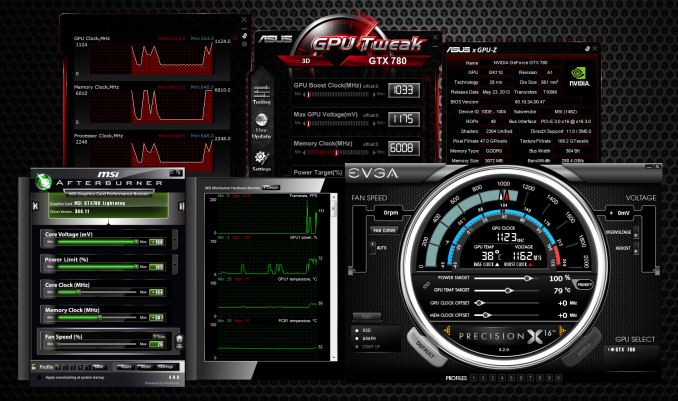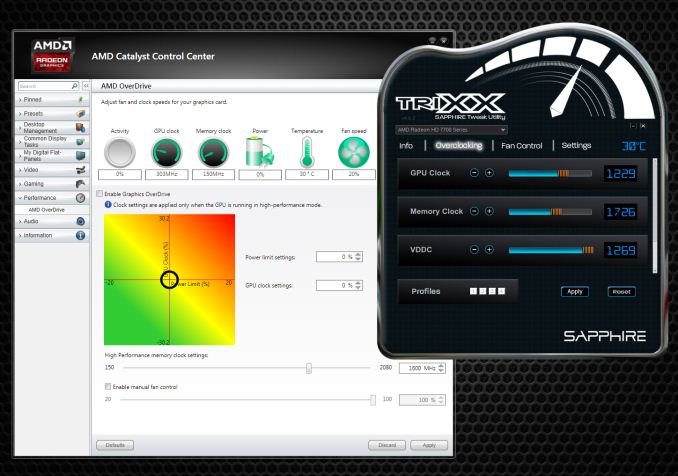The AnandTech Guide to Video Card Overclocking Software
by Michael Wilding on October 8, 2014 3:00 PM EST
Video card overclocking has become a very popular topic amongst gamers and PC enthusiasts these days. With the release of next generation games around the corner and the growing popularity of resolutions beyond 1080p, overclocking is becoming increasingly important to users looking to squeeze the most performance they can out of their video cards.
It’s been more than a decade since video card overclocking was first introduced. Back then, overclocking was considered a risky practice where only advanced users would participate. It was also looked down upon by video card manufactures and board partners alike.
Many of our seasoned readers may remember some of the more popular utilities used back in the day, such as NVMax, CoolBits, ATITools, RivaTuner, and PowerStrip. Much like today’s utilities, each had their strengths and weaknesses. Regardless of the utility used, they all had the same objective: increase the frequencies of our video cards to obtain better than stock performance. Comparing these to today’s overclocking utilities, fundamentally not much has changed. The biggest changes have to do with features and functionality, most of which can be a huge asset to users when overclocking their video cards.
Meanwhile, overclocking is no longer being shunned by video card manufactures and board partners. Instead, it's acknowledged and used in the marketing and design of many video cards, in hopes of increasing market share and brand reputation. Due to the popularity of overclocking, board partners have embraced these utilities and begun to develop them on their own. Along with developing these utilities, board partners have been marketing custom cooled and factory overclocked models to help increase profit margins, and to help broaden their product offerings as well. Additionally, video cards manufactures have been implementing safety measures to prevent users from easily damaging their video cards. Safety nets, such as the use of dynamic clock speeds and GPU throttling, have made overclocking safer and more accessible to the average user.
This article will not be a guide on how to overclock your video card; instead, we'll be doing a round-up of the utilities that help make overclocking possible. Overclocking with the use of software utilities continues to be the most popular method to date. There are over a dozen utilities that can be used to overclock today’s video cards, but today we'll only be looking at the most popular within our community. These utilities include AMD OverDrive, Sapphire TriXX, ASUS GPU Tweak, EVGA Precision X, and MSI Afterburner. As we delve into these utilities, we’ll be analyzing each of their strengths and weaknesses and discovering what separates them from each other as well. Hopefully this round-up will provide some useful data and help you decide which utility is right for you.











59 Comments
View All Comments
Iketh - Wednesday, October 8, 2014 - link
The article title is clear.Crotan - Wednesday, October 8, 2014 - link
Aren't they are just re-skins of RivaTuner. Pretty sure most of them has the fine print "powered by RivaTuner somewhere. They're all watered down versions of the once great utility that are left up to the respective company to release patches for.Michael Wilding - Wednesday, October 8, 2014 - link
MSI Afterburner is the only utility to use the RivaTuner core now.TiGr1982 - Wednesday, October 8, 2014 - link
Sapphire TriXX is indeed simple and easy to use with Radeons (used it with my HD 7950 Boost).Works fine with no issues.
Impulses - Wednesday, October 8, 2014 - link
MSI should steal some of their Afterburner devs to improve their mobo software... :pIketh - Wednesday, October 8, 2014 - link
What about undervolting? Not one mention of it.People ask all the time why undervolt video cards? Are you kidding me? Especially with a card like an EVGA 780 Ti Classified like I have.....
My card 1150MHz 1.175v stock....
Using power tune at 85% and upping core MHz, it's stable 1100MHz 1.050v ... yea that's right, over .1v reduction on a huge chip = massive power and noise savings while losing just 5% performance. Quit asking this dumb question people, and utility designers please don't leave out negative volt adjustments anymore. Even Afterburner won't undervolt my card, only OVERVOLT LOL... I overvolt this thing .075 and gain a whopping 40MHz and fans scream like they're gonna fly off their bearings and gut my pc.......
Hrel - Wednesday, October 8, 2014 - link
I totally agree! I care much more about heat/noise/power consumption/longevity than I do a miniscule, largely academic, performance improvement. I'll take a 8db drop in noise over changing my FPS from 188fps to 198fps any day.Death666Angel - Saturday, October 11, 2014 - link
Here, my 1250/6600MHz Chip/Memory OC on my AMD HD7970 is doing wonders on my 1440p 105Hz monitor. Increases the framerate in most games I play by at least a 2 digit number. It's also water cooled, as a decent graphics card should be. So no noise increase.Why would you buy a high powered card and downvolt it while also downclocking it? Your numbers are also hard to read. You overvolt .075 from 1.175 or from your 1.05? Either way, if you need to overvolt .075 for 40Mhz, you have a dud of a card and if your fans scream, you bought shit. Or stock. Which is shit if you don't get an aftermarket cooler / WC.
Michael Wilding - Wednesday, October 8, 2014 - link
Good call. While it's nowhere near as popular as overvolting, it's a good way to bring down temps and power consumption.Iketh - Wednesday, October 8, 2014 - link
I'd also like to add Asus GPU Tweak is averaging two updates a month which is far more often than Afterburner's update frequency which you gave praise for....